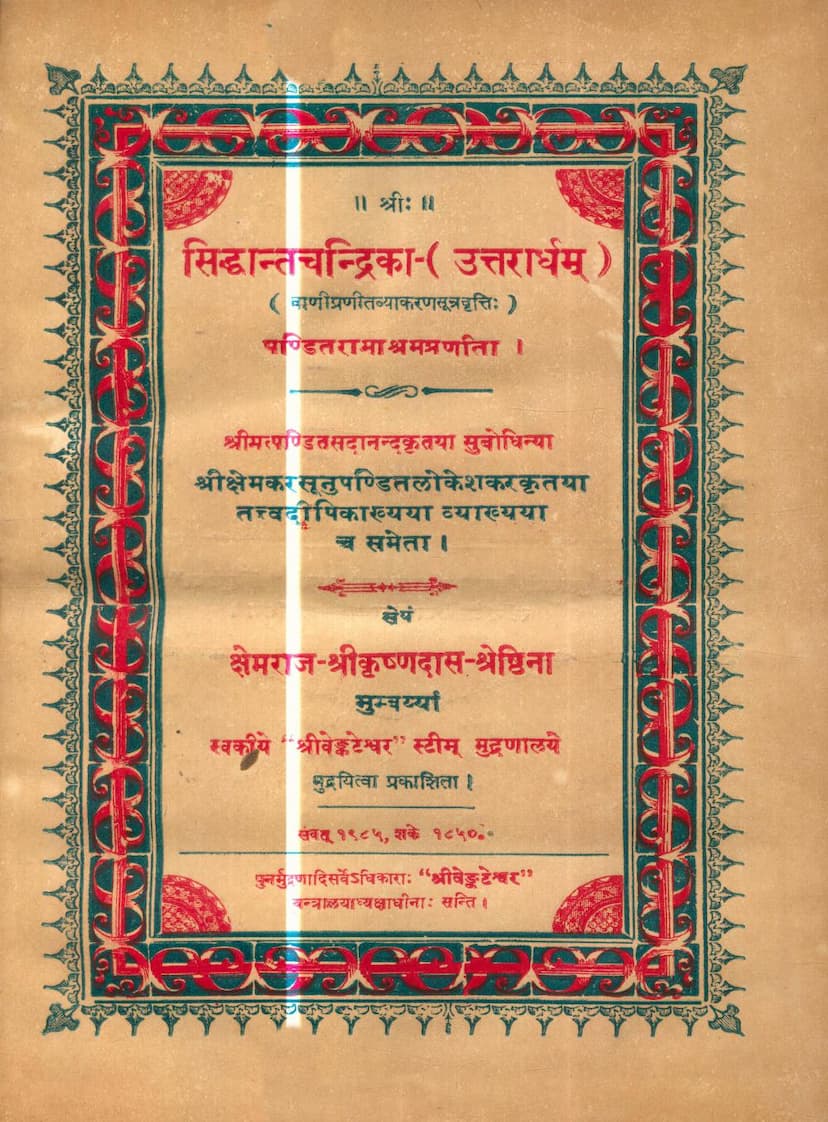Siddhant Chandrika Uttararddham
Added to library: September 2, 2025

Summary
The book "Siddhant Chandrika Uttararddham" by Kshemraj Shrikrishnadas Shreshthi, published by Kshemraj Shrikrishnadas Shreshthi, is the second part (Uttararddham) of a larger work on Jain grammar. The catalog link provided is for JainQQ.org, which lists this book.
Based on the provided pages, here's a comprehensive summary in English:
1. Title and Context:
- Title: Siddhant Chandrika Uttararddham (सिद्धान्तचन्द्रिका-(उत्तरार्धम् ))
- Author: Kshemraj Shrikrishnadas Shreshthi (क्षेमराज-श्रीकृष्णदास-श्रेष्ठिना)
- Publisher: Kshemraj Shrikrishnadas Shreshthi (क्षेमराज-श्रीकृष्णदास-श्रेष्ठिना)
- Publication Year: Samvat 1985 (1928 AD), Shake 1850.
- Nature of the Work: The title indicates it's the latter half of the "Siddhant Chandrika," a work on grammar, specifically related to the "Vani" (presumably a foundational grammar text). It is noted to be accompanied by two commentaries: "Subodhini" (सुबोधिन्या) by Sadananda Pandit (श्रीसदानन्दपण्डित) and "Tattva Deepika" (तत्त्वदीपिका) by Lokeshkar (श्रीलोकेशकर).
- Jain Text: The introductory pages explicitly state "JAIN EDUCATION INTERNATIONAL FOR PRIVATE AND PERSONAL USE ONLY" and the title itself refers to "Siddhant," suggesting a Jain philosophical and grammatical treatise.
2. Publisher's Note (Vigyapan):
- Importance of Grammar: The publisher's note highlights the paramount importance of grammar (Vyakarana Shastra) as an essential limb of Sanskrit (Girvana Vani).
- Various Grammatical Schools: It mentions that many grammarians like Indra, Kaskala, Shaakaltaya, Panini, etc., have contributed to the field, each following different paths.
- Sarasvata Vyakarana: The note specifically mentions the Sarasvata grammar, attributed to Acharya Shrī Anubhuti Swarupa, which is presented as a concise work of seven hundred sutras, composed in a single day with divine grace, and is considered easier to grasp than Panini's grammar.
- Regional Prevalence: The Sarasvata grammar is noted as being predominantly studied and taught in the region north of the Narmada river in India.
- Commentaries: The Siddhant Chandrika's "Subodhini" and "Tattva Deepika" are praised for their immense utility to scholars and students in facilitating the study and understanding of the Sarasvata grammar.
- Correction and Publication: Despite previous editions being printed, they were often found to be inaccurate. The current publication aims to rectify these issues by presenting the Uttararddham of Siddhant Chandrika along with the two aforementioned commentaries, intended to alleviate the difficulties faced by students and scholars.
- Value: The publisher acknowledges that the value of this enhanced edition, with two commentaries, is being offered at the same price as the earlier edition that had only one commentary. They request esteemed scholars to point out any remaining errors due to oversight.
- Publisher's Identity: Kshemraj Shrikrishnadas Shreshthi identifies himself as the proprietor of the "Shri Venkateshwar Steam Press" in Bombay.
3. Table of Contents (Siddhant Chandrika Uttararddham - Main Subject Division): This section provides a detailed list of the topics covered in the Uttararddham, along with the corresponding page numbers. The major sections include:
- Roots (Bhvadiah, Adadih, etc., up to Churadih) - 11 sections
- Various Tense and Mood Formations (Nyanta Prakriya, Santa Prakriya, Yanga Prakriya, Yuluganta Prakriya, Nam Dhatu Prakriya) - 5 sections
- Categorization of Roots ( Kandadih) - 1 section
- Appendices on Suffixes (Pratyaya Mala) - 1 section
- Word Arrangement (Pada Vyavastha) - 1 section
- Grammatical Processes related to Voice (Bhava Karma Prakriya, Karma Kartri Prakriya) - 2 sections
- Tense and Mood Meanings (Lakarartha Prakriya) - 1 section
- Primary Suffixes (Purva Kridanta Prakriya) - 1 section
- Unadi Sutras (Unadi - Pancha Padin) - 1 section
- Secondary Suffixes (Uttar Kridanta Prakriya) - 1 section
- Krit Suffixes (Kritya Pratyayah) - 1 section
4. Alphabetical Index of Sutra Beginnings: Pages 5 through 21 contain an extensive alphabetical index of the starting words of the sutras covered in the book, along with their respective page numbers. This index is crucial for navigating the detailed grammatical rules presented. The sheer volume of this index underscores the comprehensive nature of the grammar text.
5. Sample Sutra Analysis (Page 22 onwards): The later pages (starting from page 22) show the beginning of the actual grammatical exposition. It starts with the discussion on "Dhatu" (धातोः) and the concept of "Adhikara" (अधिकार), explaining why certain rules are applied. It then delves into the classification of roots, starting with the "Bhuwadih" (भ्वादिः) class, and discussing concepts like Atmanepada (अनुदात्तङितः, ङित्स्वरितेत उभे) and various verbal affixes. The commentaries "Subodhini" and "Tattva Deepika" are presented alongside the sutras, offering explanations and elaborations.
Overall Summary:
"Siddhant Chandrika Uttararddham" is a significant Jain grammatical work, presented with detailed commentaries, focusing on the intricate rules of Sanskrit verb conjugation and derivation within the framework of the Sarasvata grammar. It meticulously explains the formation of verbs from roots, the application of various affixes and suffixes (like Krit, Unadi, and Nyanta), the nuances of tense, mood, voice (passive, causative), and the classification of verbal roots. The presence of multiple commentaries highlights its importance in the Jain academic tradition for understanding the structure and usage of Sanskrit as applied in religious and philosophical texts. The book appears to be a highly technical and academic resource for advanced students of Jain philosophy and Sanskrit grammar.